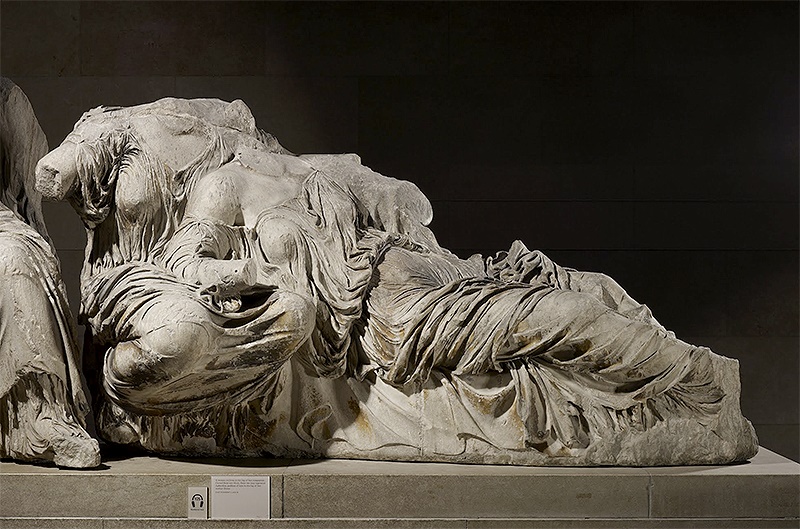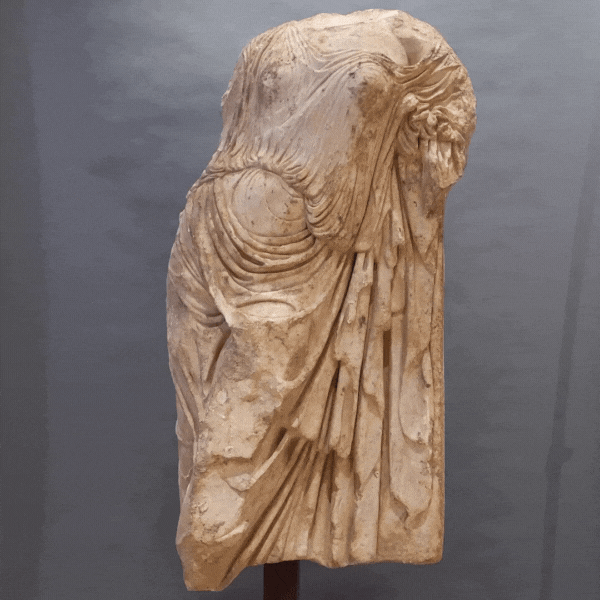A Monumental Draped Goddess: Aphrodite of the Gardens
10/06/2021 Old Master Paintings

 NEW YORK, NY -- Aphrodite of the Gardens was one of the best-known images of this important goddess in the classical period of Greek art. Today, based on sculpture and paintings from later periods, we tend to think of Aphrodite as nude; however, before the middle of the 4th century B. C. she was invariably shown as modestly clothed. A good example of how she was pictured in the mid-5th century B. C. is a painting in the bowl of an Athenian kylix, or drinking cup, from around 460 B. C. now in the British Museum. [fig. 1] Here the goddess is shown riding side-saddle on a white goose—a bird sacred to her—dressed in an elegantly embroidered chiton (a long tunic), a red himation (an enveloping cloak or shawl) and a sakkos, or snood. This is an ensemble that a well-dressed lady might have worn anywhere in the Hellenic world at the time.
NEW YORK, NY -- Aphrodite of the Gardens was one of the best-known images of this important goddess in the classical period of Greek art. Today, based on sculpture and paintings from later periods, we tend to think of Aphrodite as nude; however, before the middle of the 4th century B. C. she was invariably shown as modestly clothed. A good example of how she was pictured in the mid-5th century B. C. is a painting in the bowl of an Athenian kylix, or drinking cup, from around 460 B. C. now in the British Museum. [fig. 1] Here the goddess is shown riding side-saddle on a white goose—a bird sacred to her—dressed in an elegantly embroidered chiton (a long tunic), a red himation (an enveloping cloak or shawl) and a sakkos, or snood. This is an ensemble that a well-dressed lady might have worn anywhere in the Hellenic world at the time.
Perhaps the most famous of the images of Aphrodite from the 5th century, however, was Aphrodite of the Gardens, carved in marble by the Athenian sculptor Alkamenes around 420 B. C. In his own lifetime and later in Antiquity, Alkamenes was considered one of the best students of Phidias, the great master who directed the building of the Parthenon at Athens and who is thought to have designed most of its sculpture.
Alkamenes, whom the Roman naturalist Pliny described as “an artist of the first rank” (Natural History, XXXVI.16), probably succeeded Phidias as director of the Parthenon project when the master left Athens for Olympia around 435 B. C., and he may well have carved the superb figures of three draped goddesses at the north end of the east pediment of the temple [fig. 2].

 We know from various ancient sources that from the late 5th century B.C. until at least the 2nd century A.D. Aphrodite of the Gardens stood in or near the goddess's temple in a district of Athens outside the city walls called "The Gardens"--hence its name. The Greek traveler Pausanias, who saw the figure during his visit to Athens in the 2nd century A. D.—roughly 600 years after its creation--wrote that it was "the work of Alkamenes, and one of the most noteworthy things in Athens." (Paus. 1.19.2., trans. W.H.S. Jones). Although the original work is long lost, we have a good idea of what the figure looked like from various Roman copies. Some of the best preserved of these include examples in the Archaeological Museum in Naples (inv. 6396); in the Archaeological Museum at Heraklion, Crete (inv. 325); and in the Musée du Louvre in Paris (inv. Ma 420) [fig. 3]. Another very fine example of this series will be offered at Doyle on October 13.
We know from various ancient sources that from the late 5th century B.C. until at least the 2nd century A.D. Aphrodite of the Gardens stood in or near the goddess's temple in a district of Athens outside the city walls called "The Gardens"--hence its name. The Greek traveler Pausanias, who saw the figure during his visit to Athens in the 2nd century A. D.—roughly 600 years after its creation--wrote that it was "the work of Alkamenes, and one of the most noteworthy things in Athens." (Paus. 1.19.2., trans. W.H.S. Jones). Although the original work is long lost, we have a good idea of what the figure looked like from various Roman copies. Some of the best preserved of these include examples in the Archaeological Museum in Naples (inv. 6396); in the Archaeological Museum at Heraklion, Crete (inv. 325); and in the Musée du Louvre in Paris (inv. Ma 420) [fig. 3]. Another very fine example of this series will be offered at Doyle on October 13.
In all of these renditions, Aphrodite is shown dressed in her classic garb of chiton and himation and leaning on a pillar. The chiton is belted at the waist, creating an overflow of fabric that falls in exquisite folds across her body. Her relaxed pose, her air of urbane nonchalance, and the elegant handling of the drapery are all typical of what is called the "rich style" that emerged in Athenian sculpture and painting during the 420s B. C., pioneered by, among others, Alkamenes himself. Remarkably, a red-figure ceramic epinetron (a knee-guard used during wool-working) attributed to the Eretria Painter now in the National Archaeological Museum in Athens, painted around 420 B.C., features a drawing of Alkamenes's Aphrodite (now recast as Alcestis preparing for her wedding) [fig. 4]. This piece would have been painted very close in time to the statue's creation and its installation at Aphrodite's temple in The Gardens. Not only does the ceramic piece confirm the date of the work by Alkamenes, it also gives us an idea of the positions of the original figure's arms, the carriage of the head and the style of the hair.
It is not clear whether the original Aphrodite of the Gardens was the central figure at the temple outside the walls of Athens; however, the sculpture did provide the model for the cult image of the goddess at her sanctuary at Dafni, on the Sacred Way to Eleusis. A fragment of the upper body of that work, dated to the late 5th century B. C., is in the National Archaeological Museum at Athens (inv. 1604). [fig. 5]

The Romans identified Aphrodite with their own goddess Venus, who, like her, was a patroness of love, beauty, and procreation. Even more important, Venus was also thought, through the Trojan hero Aeneas, to be the ancestress of the Julio-Claudian emperors, and by extension of the entire Roman people. The center of her worship in Rome was the temple of Venus Genetrix (“Mother Venus”), built by Julius Caesar in the forum that bears his name. Given her connection to the Imperial family and to the founding of the city, we can imagine that a figure such as Aphrodite of the Gardens would have resonated with Roman patriotic feeling in a way that a work depicting another goddess would not have.
As previously noted, the work to be offered at Doyle is one of a series of known Roman copies of Aphrodite of the Gardens dating to the 1st Century A. D. Clearly the Romans' well-known love of Greek civilization at that time ignited an enthusiasm for copies of Greek sculpture from the classic period of the 5th century B. C. It should be noted that while the style of this piece is derived from a famous Greek model, the technique is distinctly Roman. This is particularly evident in the liberal use of the running drill, a tool that cuts the stone at a 45-degree angle rather than straight on. This direction of approach leaves deep channels in the stone's surface and creates dramatic shadows, which give the work an almost calligraphic surface appearance.
 When it was originally finished, this figure, like all Greco-Roman sculpture, would have been fully colored with encaustic, a paint composed of hot, tinted wax. Those hues are lost to us now, although we can guess at them. The drapery of some ceramic votive figures of ladies from the Greco-Roman world show traces of color, usually pastels, often in sophisticated combinations including yellows, lavenders and greens. Today the surface of the stone shows that it was buried, perhaps for many years, at some time in its history. There are small scratches, root marks and stains from other objects present wherever it was interred, as well as calcite encrustations caused by the marble’s chemical reactions with the soil. We can only guess where this beautiful work was made, and how it found its way from its home in the 1st century A. D. to a new life in the present day.
When it was originally finished, this figure, like all Greco-Roman sculpture, would have been fully colored with encaustic, a paint composed of hot, tinted wax. Those hues are lost to us now, although we can guess at them. The drapery of some ceramic votive figures of ladies from the Greco-Roman world show traces of color, usually pastels, often in sophisticated combinations including yellows, lavenders and greens. Today the surface of the stone shows that it was buried, perhaps for many years, at some time in its history. There are small scratches, root marks and stains from other objects present wherever it was interred, as well as calcite encrustations caused by the marble’s chemical reactions with the soil. We can only guess where this beautiful work was made, and how it found its way from its home in the 1st century A. D. to a new life in the present day.
